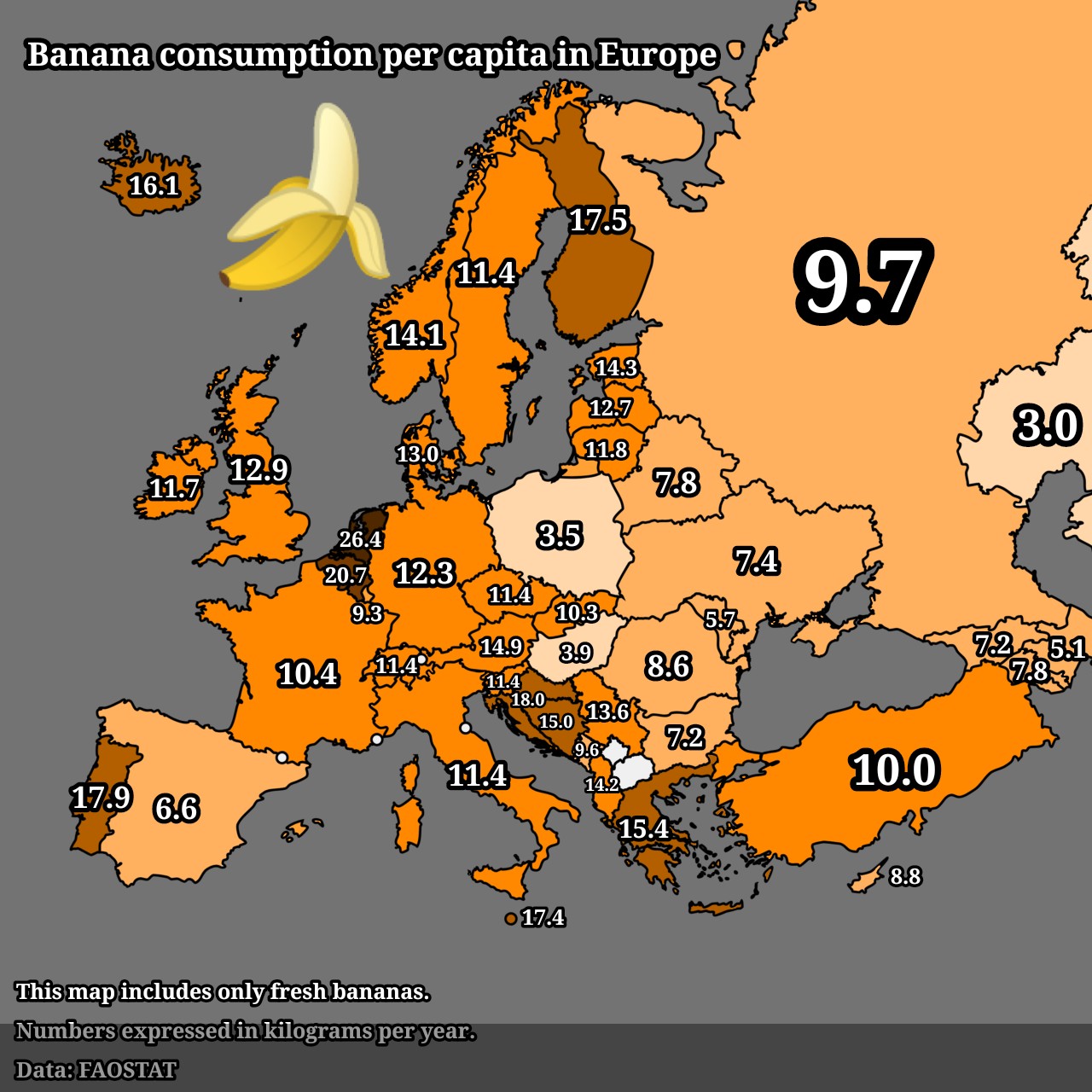Banana Consumption Per Capita in Europe Map


David Chen
Data Visualization Specialist
David Chen is an expert in transforming complex geographic datasets into compelling visual narratives. He combines his background in computer science ...
Geographic Analysis
What This Map Shows
The "Banana Consumption Per Capita in Europe" map provides a visual representation of the average banana consumption across various European countries. Each country is color-coded to indicate its per capita banana consumption, offering a clear insight into how banana preferences vary from one nation to another. This map not only highlights the popularity of this tropical fruit but also opens up a discussion about dietary habits, agricultural practices, and trade relationships in Europe.
Deep Dive into Banana Consumption in Europe
Bananas have become a staple fruit in many diets across Europe, often praised for their convenience, nutritional value, and natural sweetness. Interestingly, bananas are often the most consumed fruit in various countries, and their widespread appeal leads to significant export and import dynamics.
In terms of nutrition, bananas are rich in potassium, vitamin C, and dietary fiber, making them a healthy choice for many consumers. They are particularly popular among athletes for their energy-boosting properties, which may explain their high consumption rates in countries with active lifestyles. Have you ever wondered why bananas are often packaged and sold in bunches? This method of distribution not only caters to convenience but also aligns with consumer preferences for bulk purchases in many European markets.
When we delve into specific statistics, the European Union is a significant player in the global banana trade, with countries like Spain, France, and the United Kingdom leading in per capita consumption. Spain, for instance, often tops the charts in banana consumption, with an average of over 12 kilograms per person per year, largely thanks to its favorable climate for growing bananas in the Canary Islands. In contrast, countries in Eastern Europe, such as Poland and Hungary, show lower consumption levels, averaging around 5-6 kilograms per capita.
What’s fascinating is that banana consumption is not solely driven by health trends but also influenced by cultural factors and economic conditions. In countries where fresh produce is more readily available and affordable, the consumption rates tend to be higher. Additionally, the rise of health-conscious diets in recent years has contributed to increased banana consumption as people seek convenient and nutritious snack options.
Regional Analysis
Looking at the map, we can identify distinct patterns of banana consumption across Europe. Western European countries, particularly those with closer ties to tropical fruit trade, show higher per capita consumption rates. For example, the Netherlands, known for its robust importation networks, sees an average of around 11 kilograms per person. In contrast, Scandinavian countries like Sweden and Finland have lower consumption, often attributed to their geographical distance from banana-growing regions and differing dietary preferences.
Interestingly, Mediterranean countries not only consume more bananas but also incorporate them into various culinary traditions. In Italy and Spain, bananas are often used in desserts or blended into smoothies, reflecting a diverse approach to fruit consumption that is less common in some Northern European nations.
Furthermore, the economic factors at play can’t be ignored. The price of bananas is relatively stable compared to other fruits due to their high availability and the efficiencies of global trade. This affordability allows more people to include bananas in their diet, thus raising consumption levels in countries with stronger economies.
Significance and Impact
Understanding banana consumption trends in Europe is not just a matter of dietary interest; it has real-world implications on agriculture, trade, and health policies. As consumer preferences shift towards healthier options, the demand for bananas is likely to remain strong. This trend has prompted European countries to engage more deeply in sustainable agricultural practices and import regulations to ensure that the bananas they consume are produced responsibly.
Moreover, the map illustrates how global events, such as climate change and trade agreements, can impact banana supply chains. Future projections suggest that as climate conditions continue to change, the regions suitable for banana cultivation may shift, potentially altering the dynamics of banana consumption across Europe.
In conclusion, the "Banana Consumption Per Capita in Europe" map not only sheds light on the popularity of this fruit but also invites us to consider the broader implications of dietary habits, economic conditions, and agricultural sustainability. As we enjoy our bananas, let's also think about the journey these fruits make to our tables and the global factors that shape our consumption patterns.
Visualization Details
- Published
- August 2, 2025
- Views
- 230
Comments
Loading comments...